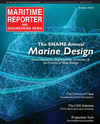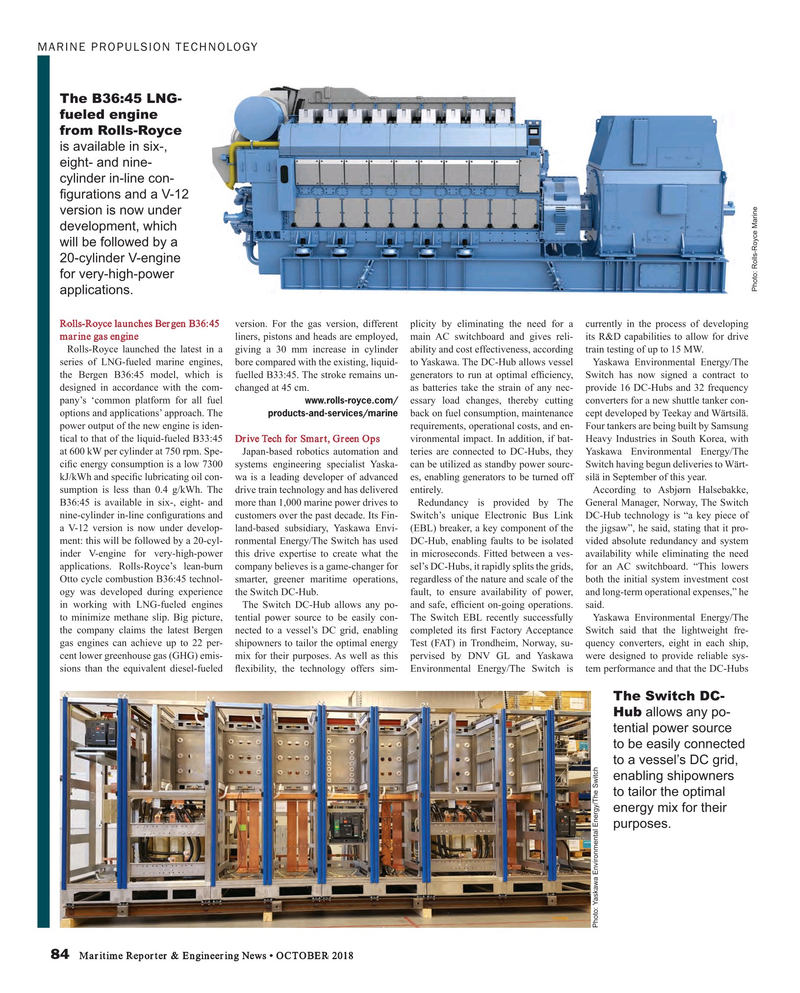
Page 84: of Maritime Reporter Magazine (October 2018)
Marine Design Annual
Read this page in Pdf, Flash or Html5 edition of October 2018 Maritime Reporter Magazine
MARINE PROPULSION TECHNOLOGY
The B36:45 LNG- fueled engine from Rolls-Royce is available in six-, eight- and nine- cylinder in-line con- ? gurations and a V-12 version is now under development, which will be followed by a 20-cylinder V-engine for very-high-power
Photo: Rolls-Royce Marine applications.
Rolls-Royce launches Bergen B36:45 version. For the gas version, different plicity by eliminating the need for a currently in the process of developing marine gas engine liners, pistons and heads are employed, main AC switchboard and gives reli- its R&D capabilities to allow for drive
Rolls-Royce launched the latest in a giving a 30 mm increase in cylinder ability and cost effectiveness, according train testing of up to 15 MW.
series of LNG-fueled marine engines, bore compared with the existing, liquid- to Yaskawa. The DC-Hub allows vessel Yaskawa Environmental Energy/The the Bergen B36:45 model, which is fuelled B33:45. The stroke remains un- generators to run at optimal ef? ciency, Switch has now signed a contract to designed in accordance with the com- changed at 45 cm. as batteries take the strain of any nec- provide 16 DC-Hubs and 32 frequency pany’s ‘common platform for all fuel essary load changes, thereby cutting converters for a new shuttle tanker con-www.rolls-royce.com/ options and applications’ approach. The back on fuel consumption, maintenance cept developed by Teekay and Wärtsilä. products-and-services/marine power output of the new engine is iden- requirements, operational costs, and en- Four tankers are being built by Samsung tical to that of the liquid-fueled B33:45 Drive Tech for Smart, Green Ops vironmental impact. In addition, if bat- Heavy Industries in South Korea, with at 600 kW per cylinder at 750 rpm. Spe- Japan-based robotics automation and teries are connected to DC-Hubs, they Yaskawa Environmental Energy/The ci? c energy consumption is a low 7300 systems engineering specialist Yaska- can be utilized as standby power sourc- Switch having begun deliveries to Wärt- kJ/kWh and speci? c lubricating oil con- wa is a leading developer of advanced es, enabling generators to be turned off silä in September of this year.
sumption is less than 0.4 g/kWh. The drive train technology and has delivered entirely. According to Asbjørn Halsebakke,
B36:45 is available in six-, eight- and more than 1,000 marine power drives to Redundancy is provided by The General Manager, Norway, The Switch nine-cylinder in-line con? gurations and customers over the past decade. Its Fin- Switch’s unique Electronic Bus Link DC-Hub technology is “a key piece of a V-12 version is now under develop- land-based subsidiary, Yaskawa Envi- (EBL) breaker, a key component of the the jigsaw”, he said, stating that it pro- ment: this will be followed by a 20-cyl- ronmental Energy/The Switch has used DC-Hub, enabling faults to be isolated vided absolute redundancy and system inder V-engine for very-high-power this drive expertise to create what the in microseconds. Fitted between a ves- availability while eliminating the need applications. Rolls-Royce’s lean-burn company believes is a game-changer for sel’s DC-Hubs, it rapidly splits the grids, for an AC switchboard. “This lowers
Otto cycle combustion B36:45 technol- smarter, greener maritime operations, regardless of the nature and scale of the both the initial system investment cost ogy was developed during experience the Switch DC-Hub. fault, to ensure availability of power, and long-term operational expenses,” he in working with LNG-fueled engines The Switch DC-Hub allows any po- and safe, ef? cient on-going operations. said.
to minimize methane slip. Big picture, tential power source to be easily con- The Switch EBL recently successfully Yaskawa Environmental Energy/The the company claims the latest Bergen nected to a vessel’s DC grid, enabling completed its ? rst Factory Acceptance Switch said that the lightweight fre- gas engines can achieve up to 22 per- shipowners to tailor the optimal energy Test (FAT) in Trondheim, Norway, su- quency converters, eight in each ship, cent lower greenhouse gas (GHG) emis- mix for their purposes. As well as this pervised by DNV GL and Yaskawa were designed to provide reliable sys- sions than the equivalent diesel-fueled ? exibility, the technology offers sim- Environmental Energy/The Switch is tem performance and that the DC-Hubs
The Switch DC-
Hub allows any po- tential power source to be easily connected to a vessel’s DC grid, enabling shipowners to tailor the optimal energy mix for their purposes.
Photo: Yaskawa Environmental Energy/The Switch 84 Maritime Reporter & Engineering News • OCTOBER 2018
MR #10 (82-89).indd 84 MR #10 (82-89).indd 84 10/5/2018 9:03:17 AM10/5/2018 9:03:17 AM

 83
83

 85
85
